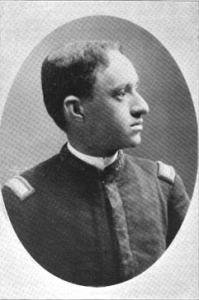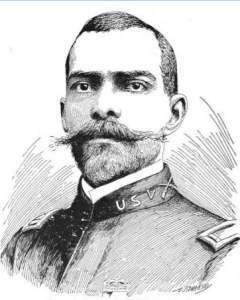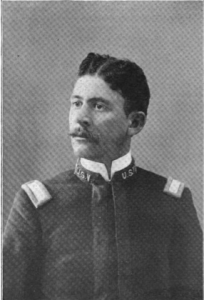The Cuban War for Independence (1895-1898) was the last of three wars waged by the Cubans for liberation from Spain. The question of U. S. involvement in the War and thus a U. S. campaign to end Spanish colonization in the Americas was hotly debated. The sinking of the USS Maine in February 1898 tilted the scale towards war, which was declared against Spain on April 24, 1898. From the landing of the first American troops in Cuba in June to the signing of the Treaty of Paris in December, the War lasted less than six months. While only approximately three hundred Americans would die in battle during the War, nearly three thousand died of disease in the humid, sweltering subtropical climate of Cuba.
At the time war was declared, the United States Army maintained four regular regiments of African American soldiers – the Ninth and Tenth Cavalry and the Twenty-Fourth and Twenty-Fifth Infantry Regiments. The War Department expressed a concern that the subtropical climate and the accompanying diseases would decimate even the heartiest of regular soldiers and volunteers from the North and upper South. Congress authorized the President to call for the raising of ten volunteer regiments made up of men, primarily from the Gulf South, who had “immunity from diseases incident to tropical climates.” These ten regiments became known as the “Immunes.” Four of the regiments, the Seventh through the Tenth, were for volunteers of color, and were broken down by state or cluster of states as to where they could recruit. The Ninth United States Volunteer Infantry was to be raised from men of color in Louisiana and put under the command of Captain Charles Judson Crane, a West Point graduate who had spent two decades working with black Regular Army soldiers.
The Ninth Volunteer Infantry was divided into twelve companies, two of which were made up of Texas recruits. The other companies were made up of men mostly from New Orleans and the area around Donaldsonville. The regiment was on active duty in Cuba from August 24, 1898 to April 25, 1899.
For many African American soldiers, service in the War was the experience of a lifetime. It gave them an opportunity to travel to a foreign country, to see people of color from outside of the Anglo world, and most important, to demonstrate their patriotism through service in yet another war. The Louisianans of color who served in Cuba would have found a familiar Latin Catholic culture, warm climate, and a large mixed-race population.
Tervalon, Villavasso, McCarthy, Carmouche, Rocque, Marmillion, Perrault, Decuir – All of these names and more are found among the ranks of the 984 men who mustered into the Ninth Volunteer Infantry in 1898. Some more well known men who served in the Ninth “Immune” Regiment were Pierre LaCroix Carmouche; Dr. John D. McCarthy; James Madison Vance; and Captain Peter Jones, who later led the Colored Waif’s Home, where Louis Armstrong was a resident.
Cuba during the Spanish-American War is the setting of La Flamenca: Drame musical en quatre acts which was composed by Lucien Lucien-Léon Guillaume Lambert (1858-1945). Lambert was a third-generation musician and composer with Creole roots in Louisiana and Saint-Domingue. His grandfather, Charles-Pierre Richard Lambert, a free man of color, (1798-1862) was a renowned teacher and composer in New Orleans in the antebellum period.
La Flamenca is set in Cuba’s capital city in 1897. It debuted at the Théâtre de la Gaîté in Paris in 1903. It features “Spanish songs of a proud and lively nature, Creole airs languorous with love, and rude and frank Yankee songs.” The central character, La Flamenca, is a Creole of Cuba and a songstress, whose interest is in the independence of her country from Spain. Flamenca falls in love with Torres, a Spanish officer, and tries to save him from Jackson, a rude American “Rough Rider.”
The performing company OperaCréole will stage La Flamenca at the Marigny Opera House in New Orleans on May 19th-21st, 2017. This will be the American premiere of the highly dramatic La Flamenca. OperaCréole is a non-profit company dedicated to researching and performing lost or rarely performed music, and sharing with the community the contributions of composers and performers of color, with a special emphasis on Louisiana and the Creole Atlantic. For more information or to to obtain tickets visit: www.marignyoperahouse.org or www.operacreole.com.
Source: Coston, William Hilary. The Spanish-American War Volunteer; Ninth United States Volunteer Infantry Roster and Muster; Biographies; Cuban Sketches. Middletown, PA: Self-Published, 1899.
Jari Honora







I believe my paternal great grandfather served in that war. Do you have a roster? How can I check it?
His last name was Faustina.
Fascinating
Thank you so much for this article.OperaCreole is really excited to bring the musical work of a son of New Orleans back home!
Joseph Jones was a corporal in the Army not a captain. He was called captain by his community in New Orleans.